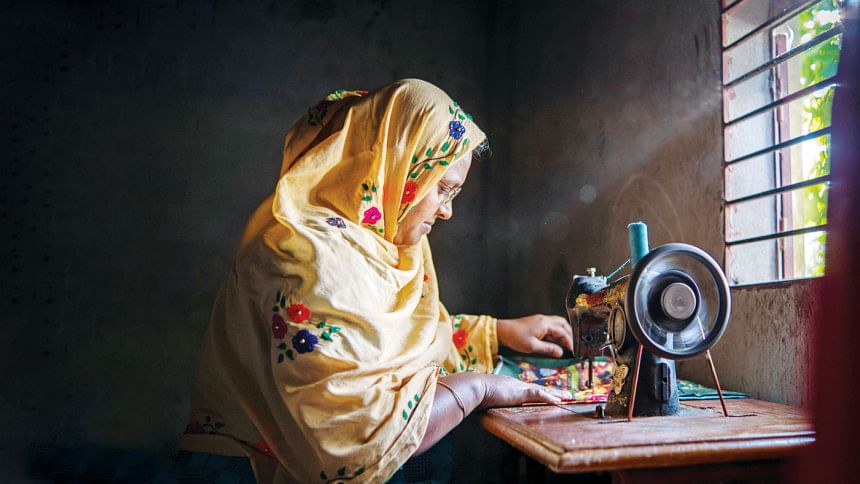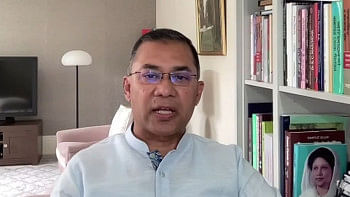Restoring vision, restoring lives

Imagine a world where everything looks faded. The colours around you do not seem as enchanting as they once appeared; your children no longer ask you to sew that hemline or help with the accounts. Memories fade fast along with your eyesight and you slowly begin to feel useless.
Although a widely overlooked aspect of public health, ensuring proper eye health is critical. It is not only about medical intervention, but also a strategic component of economic growth for a workforce.
Stories from the ground
Sree Badal Tripura is an elderly fisherman from the village of Tripura Bari in Balia, Farakkabad, Chandpur. It was not until a relative pointed out Tripura's squinting and difficulty recognising faces that his poor eyesight was noticed.
The intervention led him to visit an eye hospital, where he was diagnosed with cataracts in both eyes. Thanks to a cooperation programme by an NGO, Badal received the necessary surgery free of cost, proving a vital point: vision impairment is not merely a personal health issue but a significant socioeconomic challenge, especially for the low-income workforce.
Millions of people suffer from vision impairment or blindness, with a vast number being treatable conditions such as refractive errors and cataracts. These conditions disproportionately affect lower-income workers, who often engage in manual labour that demands sharp vision.
Empowering tea plantation workers and marginalised communities through accessible eye health care is not just about vision -- it's about dignity, opportunity, and building a future where everyone can see their potential.
Mohini Rabi Das, a 52-year-old tea plantation worker from Sreemangal, began experiencing vision problems several years ago. Mohini's deteriorating eyesight severely hampered her ability to work, yet financial constraints kept her from seeking necessary medical help.
Like Badal Tripura, her story took a hopeful turn when she attended a free eye camp organised in her community.
"I was almost resigned to a life blurred and confined to shadows. The eye camp was a blessing," Mohini expressed.

Impact of corrective measures on productivity
For many, simple access to affordable spectacles can transform lives, offering an effective solution to the common problem of refractive errors.
The Fred Hollows Foundation is an international development organisation that aims to provide access to quality eye health care irrespective of their economic background. The Foundation works for inclusive health care with a collaborative approach towards a transformational change ensuring the right to sight.
Programmes that distribute free or low-cost glasses have shown remarkable success in improving productivity and reducing accidents in workplace settings.
Musabbir Alam, country manager of The Fred Hollows Foundation, said, "Vision impairment can limit people's ability to work, learn, and participate fully in society. By prioritising eye health initiatives, we can ensure that these communities not only see clearly but also envision a brighter future for themselves and their families."
He added, "Empowering tea plantation workers and marginalised communities through accessible eye health care is not just about vision -- it's about dignity, opportunity, and building a future where everyone can see their potential."

Role of collaborative efforts
A study, conducted among tea workers in India, a demographic and economic parallel to many in Bangladesh, showed a noteworthy increase in productivity when workers were provided with corrective glasses.
Workers who received glasses saw an increase in their daily tea-picking output by approximately 21.7 percent, demonstrating that even basic vision correction can dramatically improve economic output.
Vision Spring, a US-based social enterprise active in Bangladesh, provides affordable eyeglasses, vision screening, and training for non-profits, social entrepreneurs, government agencies, and corporate clients.
Having poor vision made it difficult to cut fabrics accurately, and I often ended up wasting materials. Once I got my spectacles, it was like seeing a whole new world. I can make precise cuts, increased speed, and there's less waste.
Ashna Afroze Ahmed, resource mobilisation lead at Vision Spring, underscored the extensive need for corrective vision care sectors like the ready-made garments sector, noting that since 2018, they have screened over 3,50,000 workers, with 30 percent needing eyeglasses.
"What is striking is that 80 percent of these workers acquired their first-ever pair of eyeglasses under our programme," she said, emphasising the widespread unmet need for vision correction among RMG workers.

Joybunessa, a garment worker in her 30s, shared her experience: "Having poor vision made it difficult to cut fabrics accurately, and I often ended up wasting materials. Once I got my spectacles, it was like seeing a whole new world. I can make precise cuts, have increased speed, and there's less waste."
Nazir Rahim Chowdhury, vice chairman of MIM Fashion Wear Ltd, was unaware of the seriousness of his employees' eyesight issues until one day an eye screening test was conducted among the workers.
Chowdhury mentioned, "I was unsure about conducting an eye test on our factory workers. However, as we run other programmes to ensure the factory's employees' well-being, I thought, why not? About 800 to 900 of our employees participated in the test and among approximately 300 to 320 workers were suffering from some kind of eye problems. I was shocked by the result given that most of our employees are in their 30s."
Integrating eye care into public health
Regular eye screenings within the existing health infrastructure could ensure early detection and treatment of common eye conditions. NGOs play a vital role in bridging the healthcare gap by providing subsidised or free eye care services.
However, the sustainability of these initiatives often relies on continuous donor support. Government involvement in facilitating and funding eye health programmes can lead to more sustainable outcomes.
Policies aimed at subsidising the cost of eyeglasses or funding cataract surgeries could be a boon for millions. By improving access to affordable eye care, educating the public about eye health, and integrating these services into the broader healthcare system, our country can protect its most valuable asset -- its people.

 For all latest news, follow The Daily Star's Google News channel.
For all latest news, follow The Daily Star's Google News channel. 





Comments